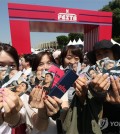- California Assembly OKs highest minimum wage in nation
- S. Korea unveils first graphic cigarette warnings
- US joins with South Korea, Japan in bid to deter North Korea
- LPGA golfer Chun In-gee finally back in action
- S. Korea won’t be top seed in final World Cup qualification round
- US men’s soccer misses 2nd straight Olympics
- US back on track in qualifying with 4-0 win over Guatemala
- High-intensity workout injuries spawn cottage industry
- CDC expands range of Zika mosquitoes into parts of Northeast
- Who knew? ‘The Walking Dead’ is helping families connect
Lotus lanterns light up Seoul ahead of Buddha’s Birthday

People enjoy looking at colorful lotus lanterns lit along the Cheonggye Stream in Seoul on May 13, 2015, ahead of Buddha’s Birthday, which falls on May 25. (Yonhap)
By Chung Ah-young
More than 100,000 colorful lanterns will light up the heart of Seoul on May 15-17 at Yeondeunghoe and at the Lotus Lantern Festival ahead of Buddha’s Birthday on May 25.
The Yeondeunghoe Preservation Committee held a lighting ceremony on April 29 with a 20-meter-high lantern shaped like the Mireuksaji stone pagoda in Gwanghwamun Plaza ahead of the festival. The pagoda is the oldest and highest stone pagoda, boasting the essential beauty of stone sculpture in Korea.
The festival dates back to the Silla Kingdom (B.C. 57-935 A.D.) and was conducted as the Lotus Lantern Assembly in Goryeo Kingdom (918-1392), and then continued as the Lantern Celebration (Gwandeung-nori) during the Joseon Kingdom (1392-1910).
The festival committee said that floats and parade lanterns in various shapes such as dragons, elephants, phoenixes, drums, turtles and lotuses, made by nationwide temples will decorate the main streets, along with the staging of a variety of programs and events.
This year’s Lantern Parade, the highlight of the festival, will extend its course from Dongguk University to Dongdaemun, Jongno and finally Gwanghwamun Plaza on May 16.
Under the theme of “Peaceful Mind, Harmonious World,” some 300 high-profile Buddhist monks, such as Ven. Sangaraja from Cambodia and Deputy Supreme Patriarch of Siyam Nikaya from Sri Lanka will convene at Gwanghwamun Plaza to pray for the peace on the Korean Peninsula and the world to mark the 70th anniversary of the nation’s liberation from Japanese colonialism, which ended in 1945.
“The lantern parade will end at Gwanghwamun Plaza this year. All the participants will meet together there and pray for the peace,” said Hong Min-seok, an official of the committee.
Also, colorful paper flowers called “jihwa,” which were dyed with natural pigments, will adorn the festival’s parade route. A variety of lanterns crafted by temples nationwide will represent their unique characteristics and symbols.
As an increasing number of foreigners take an interest in the festival every year, the committee will provide “Yeondeunghoe Global Supporters” or a youth volunteer group to assist festival-goers. Some 300 foreign tourists will also join the parade, holding lanterns they have made.
On May 17, various traditional cultural events will be held in front of Jogye Temple, with booths providing Buddhist art, temple food and folk games to visitors.
During the festival, a lantern exhibition will be held in Jogye Temple, Bongeun Temple in Samseong-dong and Cheonggye Stream. The Buddhist assembly will take place nationwide on May 25 to celebrate Buddha’s Birthday.
The festival is designed to pray for the welfare of the community and achievement of personal wishes among Buddhists, and to reflect Buddha’s teachings of compassion and wisdom every year. The lanterns symbolize light, compassion and wisdom.

















Pingback: Birthday Wishes Buddhist Monk | free ecards